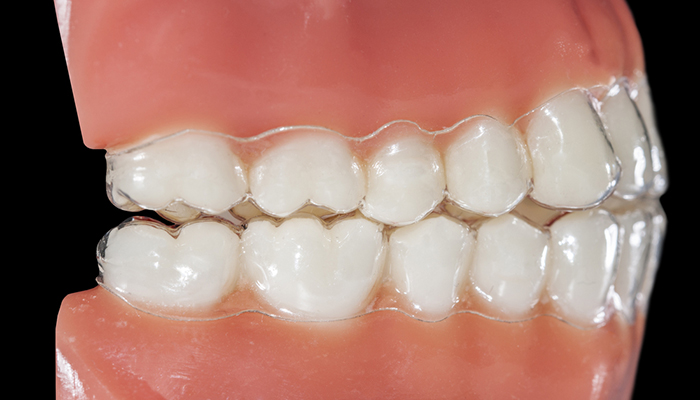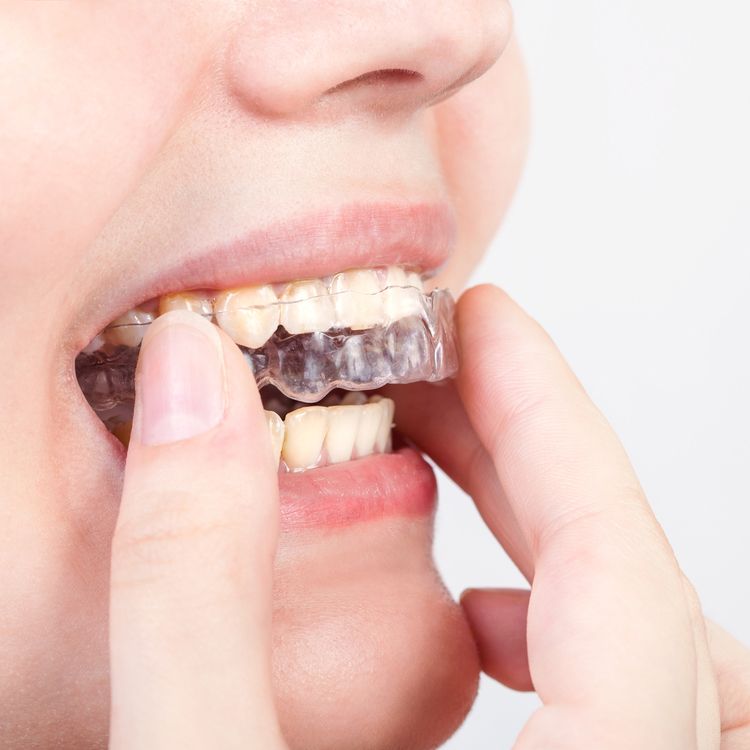Your occlusion, or bite, refers to the way your teeth come together. The word occlude means to close. Sounds simple enough, right? There are many moving parts that are involved in occlusion. Your joints, muscles, teeth and jaws must all align perfectly for a well-functioning occlusion. Let’s take a look at how a healthy bite looks.
In a healthy bite, the jaws are well matched in size, and the size of the teeth is proportionate to the size of the jaws. The teeth are aligned and when they come together, they allow the joint to sit supported in its natural position with the muscles in a relaxed and balanced state. It’s like dental nirvana.
If you’ve ever looked at a tooth, you will notice that there are little points or cusps on them. In a proper occlusion, the cusps of the teeth are arranged so that they fit into the grooves of their partners, similar to the way the sides of a zipper interlock.
When you bite, all the teeth should meet at the same time and with equal pressure. The upper jaw is slightly larger than the lower jaw and overlaps the lower teeth just a little bit. The front teeth will also have slight overlap and the middle of the face will correspond with the midline of the two front teeth. Everything is nice and balanced. Chewing occurs without interference and the cusps of the top teeth guide the tissues to protect the cheeks while the cusps of the lower teeth protect the tongue. Harmony. Everything glides along without your ever having to give it a second thought.
What is a Bad Bite?
A bad bite or malocclusion is when things do not harmonize. There are many factors that can affect occlusion such as
- Skeletal problems
- Overgrowth of one or both jaws
- Underdevelopment of one or both jaws
- Abnormal form of arches
- Thumbsucking
- Tongue thrusting
- Mouth breathing
- Anterior open bite
- Dental problems
- Teeth being too small or too large for jaw
- Resulting in gaps or crowding
- Misalignment of teeth
- Misalignment of jaws
- Too many teeth
- Lost or missing teeth
- Teeth being too small or too large for jaw
When your jaws are unable to bring your teeth together normally, things begin to malfunction. Your occlusion is a system. When one part fails, you will see a breakdown in other areas. It’s like a car with a flat. One little piece can bring the whole system to a halt. Let’s see how!
What are the types of Malocclusion?
First, let’s learn some terms to make understanding a bad bite easier. When your dentist evaluates your bite, they are looking for a few key features.
- Overjet – How far the top teeth protrude past the lower front teeth
- Overbite – How much the top front teeth overlap the lower front teeth
- Jaw Relationship – or Class is determined by where the top and bottom first molars are in relation to each other
- Crossbite – Teeth meet improperly with some or all of the upper teeth falling within the lower arch
- Open bite – when teeth don’t fully occlude leaving an opening. Can be due to thumbsucking or other parafunctional habits or skeletal abnormalities.
There are different types of malocclusions. When we classify them, we are really just grouping similar features together. Keep in mind that malocclusion is not a disease.
How do You Classify a Bad Bite?
One question we ask is, what is the position of the jaws in relation to each other? Is the upper jaw in front of the lower jaw? Is the lower jaw set back very far? Or is it pushed out beyond the upper jaw? These questions help us group bites into one of three relationships:
Class I
When the jaws develop in the proper relationship to each other and to the skull, they are in a class I relationship. In this position, the upper jaw is slightly larger than the lower jaw and the lower arch fits into the upper arch with very little overlap of the upper teeth. This is where we like to be. If all the teeth are aligned, this is an ideal bite. This bite gives a rather straight profile.
A class I malocclusion occurs when the jaws are in proper position, but the teeth are not. It is caused by things such as:
- Crowding due to teeth being too large or arch being too small
- Spacing due to arch being too large or teeth being too small
- Missing teeth
- Rotated teeth
- Misaligned teeth
Class II
A class II malocclusion is when the upper jaw is out in front of the lower jaw. Sometimes this type of bite is incorrectly referred to as an overbite. This position gives the bucktooth appearance. It can be caused by an overdeveloped upper jaw or an underdeveloped lower jaw. This bite tends to look convex in profile. There are two types of Class II bites, both have a higher association with temporomandibular joint dysfunction (TMD)
- Division I
- The typical bucktooth appearance with protruding front teeth and a small set back lower jaw
- Divison II
- The top teeth don’t stick out. Large Overbite or deep bite where the top front teeth nearly cover the lower front teeth.
Class III
A class III malocclusion is when the lower jaw protrudes forward either because the mandible is overdeveloped, the maxilla is underdeveloped, or a combination of both. It can even happen if the teeth don’t meet properly when closing. Sometimes as the jaw closes, a tooth will strike a tooth from the opposite arch and drive the jaw forward. This type of bite is also called an underbite and looks concave in profile.
Why is Your Bite Important?
Function
Now that you have an idea of the different types of jaw relationships–Class I, II, and III, let’s take a closer look at how the teeth come together. Imagine someone has a Class II relationship of the jaws–that’s when the lower jaw is too far behind the upper jaw. Now, imagine the jaw hinging closed. What happens to the teeth? Can they meet correctly? With this type of bite, the lower molars are further back than their ideal position. Chewing and swallowing can be altered putting strain on the muscles and the joint.
When the teeth don’t hit properly, no matter what the reason, the entire system is affected. The muscles have to compensate, the joint can be pulled out of place and destabilized and pain and altered function can occur.
The Class II malocclusion can also contribute to other problems, such as a restricted airway that can contribute to obstructive sleep apnea (OSA).
Appearance
When a bad bite is caused by a skeletal problem, appearance can be greatly affected. Facial proportions are tied to aesthetic appearance. When those proportions are altered, it can be perceived as unattractive.

What Are the Signs I Have a Bad Bite?
Not all bad bites are obvious. If your jaws are in a normal relationship to each other and to your skull and you have straight teeth, they may be hard to spot. But, even minor interferences can cause some big problems! A single faulty fuse can wreak havoc. Sometimes, a bad bite will cause symptoms like:
- Jaw pain
- Tooth pain
- Tooth sensitivity
- Headaches
- Facial pain
- Pain in the neck and back
- Sore gums
- Teeth not fitting together well
If you have any of these symptoms, make an appointment with your dentist to talk about your bite. Your dentist routinely examines your teeth for other signs of a malocclusion like:
- Excessive wear
- Broken or chipped teeth
- Unusual patterns of wear
- Notching at gum-line
- Soft tissue changes
When Should I Have My Child’s Bite Evaluated?
Your dentist is trained to evaluate occlusion. It is important to take your child for routine visits starting when their teeth start coming in. As with most things, the earlier a problem is recognized, the easier the treatment! Children develop at different rates, and your dentist will be able to advise you if they recognize any problems. The American Association of Orthodontists recommends an evaluation at age 7.
How Do You Treat a Bad Bite?
Depending on your bite, treatments will vary. The most common forms of treatment include
- Orthodontics
- Expansion of arches
- Braces
- Appliances
- Extraction
- Enamel recontouring to remove interferences
- Restorations to close large spaces
- Splint therapy for diagnostics
- Nightguard
- Oral surgery to correct skeletal deformities
Do I Really Have to Treat Crowding?
Your dentist will evaluate the amount of crowding and make a recommendation. Mild crowding may not need to be treated at all. More severe crowding may require treatment to correct alignment. Crowded teeth are harder to clean and can cause
- Decay
- Gum disease
- Inflammation
- Staining
- Chewing problems
Remember, early intervention is key! If your dentist can spot a problem early, many times severe crowding can be minimized.
What Happens if I Don’t Treat a Bad Bite?
Not all bites are treated the same nor do they cause the same problems. Your dentist will advise you of the recommended treatment and consequences of non-treatment. Because teeth do not regenerate, and the mouth is such a precise system, bite issues should not be ignored. What is a little wear today can turn into a major breakdown in the future. Your dentist is well trained to spot early changes and to get you back on the right track.

